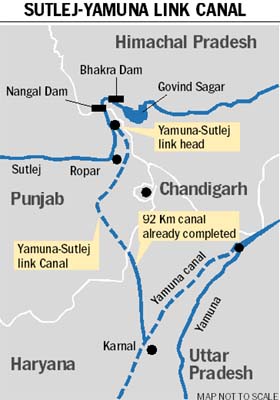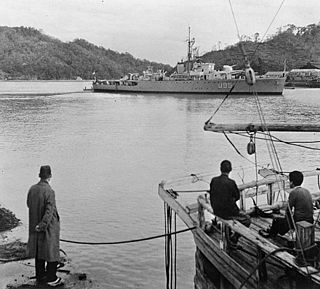The Sutlej is a river in northern India and Pakistan.
Contents
Sutlej may refer to the following subjects:
The Sutlej is a river in northern India and Pakistan.
Sutlej may refer to the following subjects:
Five ships of the Royal Navy have borne the name HMS Ark Royal:

HMNZS Achilles was a Leander-class light cruiser, the second of five in the class. She served in the Royal New Zealand Navy in the Second World War. She was launched in 1931 for the Royal Navy, loaned to New Zealand in 1936 and transferred to the new Royal New Zealand Navy in 1941. She became famous for her part in the Battle of the River Plate, alongside HMS Ajax and HMS Exeter and notable for being the first Royal Navy cruiser to have fire control radar, with the installation of the New Zealand-made SS1 fire-control radar in June 1940.

The Yamuna is the second-largest tributary river of the Ganges by discharge and the longest tributary in India. Originating from the Yamunotri Glacier at a height of about 4,500 m (14,800 ft) on the southwestern slopes of Bandarpunch peaks of the Lower Himalaya in Uttarakhand, it travels a total length of 1,376 kilometres (855 mi) and has a drainage system of 366,223 square kilometres (141,399 sq mi), 40.2% of the entire Ganges Basin. It merges with the Ganges at Triveni Sangam, Allahabad, which is a site of the Kumbh Mela, a Hindu festival held every 12 years.
Ten ships of the Royal Navy have borne the name HMS York after the city of York, the county seat of Yorkshire, on the River Ouse.

The Cressy-class cruiser was a class of six armoured cruisers built for the Royal Navy around 1900. Their design’s incorporation of a pair of 9.2-inch guns and armoured sides served to address criticism directed against the previous Diadem class — advances made possible by their 1,000 ton increase in displacement over their predecessors. The ships were notably stable, except for a susceptibility to pitching.
Several ships of the British Royal Navy have been named HMS Boxer, named after the competitor in a boxing match.
Nine ships of the Royal Navy have borne the name HMS Shannon, after the River Shannon, the longest river in Ireland:

Maritime powers in the Indian subcontinent have possessed navies for many centuries. Indian dynasties such as the Cholas used naval power to extend their influence overseas, particularly to Southeast Asia. The Marakkar Navy under Zamorins during 15th century and the Maratha Navy of the 17th and 18th centuries fought with rival Indian powers and European trading companies. The East India Company organised its own navy, which came to be as the Bombay Marine. With the establishment of the British Raj after the Indian Rebellion of 1857, the small navy was transformed into "His Majesty's Indian Navy", then "Her Majesty's Indian Marine", and finally the "Royal Indian Marine".

The Sutlej or Satluj River is the longest of the five rivers that flow through the historic crossroads region of Punjab in northern India and Pakistan. The Sutlej River is also known as Satadru. It is the easternmost tributary of the Indus River. The Bhakra Dam is built around the river Sutlej to provide irrigation and other facilities to the states of Punjab, Rajasthan and Haryana.

The Shoreham-class sloops were a class of eight warships of the Royal Navy built in the early 1930s.

HMS Sutlej was a Cressy-class armoured cruiser built for the Royal Navy around 1900. Upon completion she was assigned to the China Station. In 1906 she became a training ship for the North America and West Indies Station before returning home and being assigned as the flagship of the reserve Third Fleet in 1909. Relieved as flagship in 1910, she remained in reserve until the beginning of World War I in August 1914.
Three ships of the Royal Navy and Royal Indian Navy have borne the name HMS Sutlej, after the Sutlej, a river that flows through modern day India and Pakistan:

HMS Sutlej was a Constance-class 50-gun fourth-rate frigate of the Royal Navy.
Three ships of the Royal Navy have borne the name HMS Jumna, after another name for the Yamuna River in India. A ship of the Royal Indian Navy has been named HMIS Jumna:

Satluj Yamuna Link Canal or SYL as it is popularly known, is an under-construction 214-kilometer (133 mi) long canal in India to connect the Sutlej and Yamuna rivers. However, the proposal met obstacles and was referred to the Supreme Court of India. It was defined as river water sharing between the states of Punjab and Haryana.

HMIS Narbada (U40) was a Modified Bittern class sloop, later known as the Black Swan class, which served in the Royal Indian Navy (RIN) during World War II.

HMIS Sutlej (U95) was a modified Bittern-class sloop, later known as the Black Swan class, which served in the Royal Indian Navy (RIN) during World War II.

HMIS Kistna (U46) was a Black Swan-class sloop which served in the Royal Indian Navy (RIN) during World War II.
Western Yamuna Canal is canal in river Yamuna that was dug out and renovated in 1335 CE by Firoz Shah Tughlaq. In 1750 CE, excessive silting caused it to stop flowing. The British raj undertook a three-year renovation in 1817 by Captain GR Blane of the Bengal Engineer Group. In 1832-33 Tajewala Barrage dam at Yamuna was also built to regulate the flow of water, and later Pathrala barrage at Dadupur and Somb river dam downstream of canal were constructed in 1875-76. In 1889-95 the largest branch of the canal Sirsa branch was constructed. The modern Hathni Kund Barrage was built in 1999 to handle the problem of silting to replace the older Tajewala Barrage.